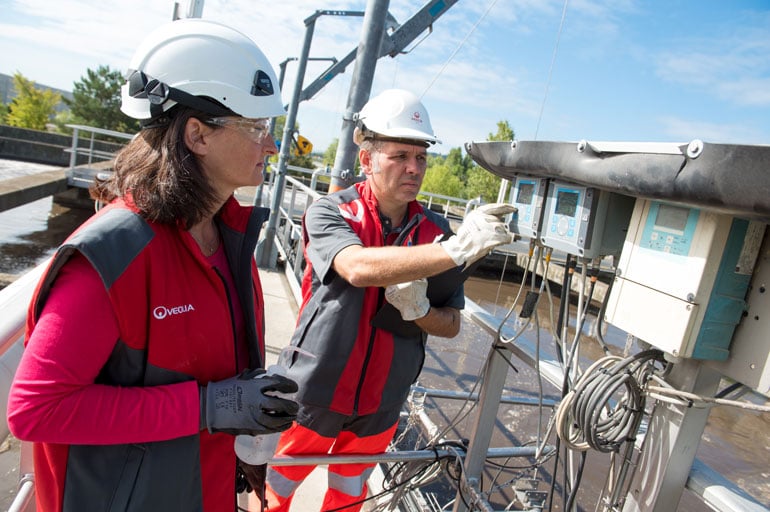Many industrial facilities with on-site wastewater treatment plants will face exceedance issues that threaten their National Pollutant Discharge Elimination System (NPDES) permit compliance. These problems are often the result of both human and equipment errors, but are almost always preventable.
Often the issues are small and easily fixed, but facilities over their effluent limit for one or more pollutants are at risk of receiving notices of violation, being fined or even shutting down their plants.
Below are the most common wastewater exceedance mistakes we’ve seen and how your facility can avoid them:
1. No formalized process control management plan (PCMP) with standard operating procedures (SOP)
Many industrial facilities believe they have standard operating procedures in place for their wastewater plant, but if those procedures are not recorded in a formalized PCMP where they can be readily accessed by anyone who needs them, the facility is at risk.
Having consistent testing and audit schedules that are well understood and easy to follow are vital to ensuring a reliable production process. That is especially true if a facility is already having issues with hiring, training and retaining staff as the loss of one person with institutionalized knowledge can be detrimental to wastewater operations. An effective PCMP includes acceptable ranges for field readings and laboratory results. When the results are outside the range, the program includes clear steps for the operator to take to mitigate the process upset.
Another common mistake facilities make is failing to properly report or address exceedances, which puts their facility at risk of facing surcharges, fines and possibly a shutdown. A good PCMP will help prevent exceedances, but also ensure consistent reporting if or when they do encounter exceedance challenges.

2. No maintenance and/or computerized maintenance management system (CMMS) integration
Equipment maintenance is critical to ensuring optimal operational performance, but some facilities don’t have asset management systems or formal maintenance plans for their equipment. As a result, many operators don’t know when equipment is due for maintenance and something has to break before they address it.
Failing to do regular maintenance can prematurely age equipment, impact production or potentially cause a plant shutdown if the problem is large enough. A CMMS helps manage maintenance so that smaller problems don’t turn into larger problems that can affect plant production and permit compliance.
3. High chemical dosing
At the first sign of exceedance trouble, some operators will overcompensate by adding more chemicals than needed. With rising chemical costs, this practice is a waste of money that can also create additional problems.
For example, operators trying to address a settleability problem may add polymer, but if they add too much it creates a negative charge that actually prevents flocculation and makes the problem worse. Additionally, high amounts of polymer can blind filter presses and media, leading to other pollutant problems.
Responding to an emergency effluent issue in this way can both be prevented and corrected with use of a solid SOP and SCADA (supervisory control and data acquisition) system. Standardized procedures, uniform monitoring and dose control can help forecast and adjust for chemical consumption to prevent the under or over use of chemicals to correct effluent issues.
4. Inefficient energy use
Many facilities tend to expend more power than needed in certain processes. Implementing tighter controls over these processes can often make them significantly more efficient.
A common example involves the overuse of aerators, fans or blowers in activated sludge processes. Oxygen is needed to feed the “bugs” in aerobic treatment, but typically the amount of air used is far more than is necessary. It’s also common to see inefficiencies in pumping systems (overpumping, recycling excess flow, etc.). Aeration and pumping systems tend to represent the largest power users in industrial wastewater treatment.
Rising energy costs make reevaluating power use very important to running a cost-efficient operation.
5. Ignoring pH balance
An imbalance of pH is problematic on its own because it can affect NPDES compliance, but it’s also vital to keeping the delicate chemistry in your wastewater balanced so that it doesn’t impact other pollutants in your waste stream. For example, a lower pH can cause certain metals such as chromium, nickel, copper, iron and zinc to fall back into solution and end up in the effluent rather than the sludge. A pH difference of 1 or 2 tenths of a unit can make the difference between compliant and noncompliant
Good process monitoring and SOPs will outline instrument calibration procedure and frequency, as well as daily “spot checks” for critical measurements, such as comparing the field instrument with laboratory results
6. Overloading sludge
Balancing sludge inventory is vital to preventing a variety of pollutants from causing exceedances. In a solids contact clarifier, the sludge acts as the filtration media and delivers a higher effluent quality compared with no sludge blanket. However, overloading a clarifier with solids will cause carry-over and potential exceedance.
Therefore, balancing the sludge volumes correctly contributes to the highest performance. Sludge blankets should be routinely measured and the process adjusted to maintain the ideal inventory.
Below are some of the most common exceedance issues we see industrial facilities face in the metals, chemicals, pharmaceutical, food and beverage and electronics industries.
| Biological oxygen demand (BOD) | Phosphorus |
| Chemical oxygen demand (COD) | Aluminum |
| Fat, oil, grease (FOG) | Total suspended solids (TSS) |
| Total petroleum hydrocarbons (TPH) | Copper |
| Cyanide | Nickel |
| Ammonia | Zinc |
| Arsenic | Iron |
| Chromium | pH |
| Nitrates | Toxicity |
| Nitrites | Temperature |
Facilities facing staffing shortages are the ones most likely to cut corners in their operations, but also have a reduced ability to quickly fix a problem that could result in a shutdown. The time gained on the front end is likely never worth what could be lost on the back end (e.g. downtime, damaged equipment, exceedances, etc.). Tighter operational process controls are always a good time investment that can prevent a worst-case-scenario.


